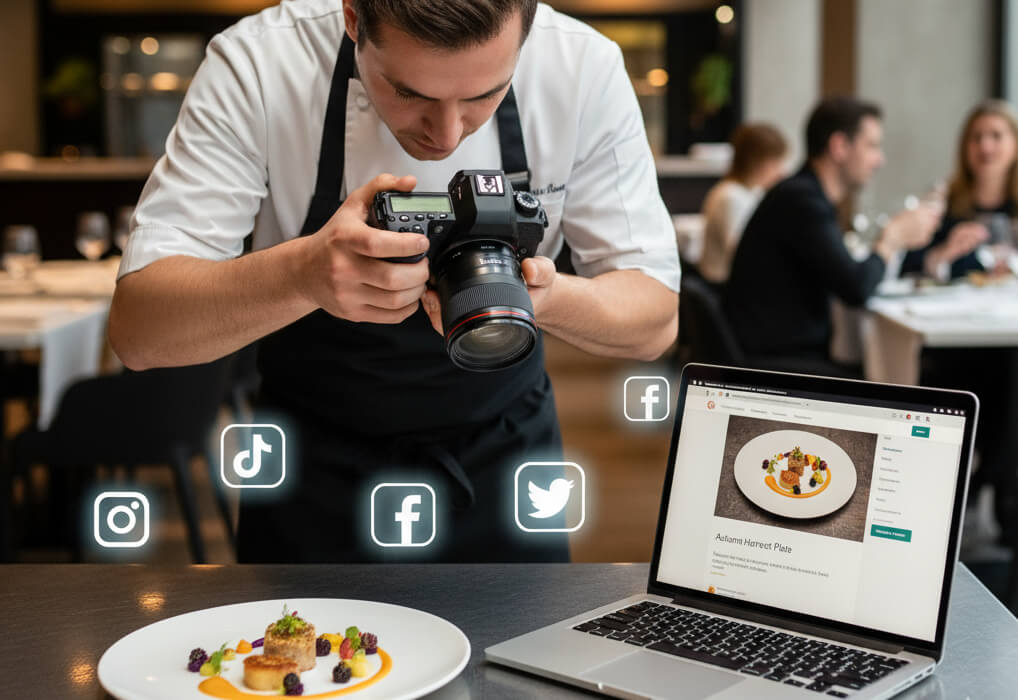October 07, 2025

In today’s digital age, a restaurant’s online presence is far more than just an online menu—it’s a marketing powerhouse. By utilizing content marketing strategies such as blogs, high-quality photos, and engaging social media posts, restaurants can boost visibility and drive more diners to their doors.
A strong restaurant website is foundational to this strategy. It serves as the central hub where you can showcase your menu, tell the story behind your dishes, and optimize for search engines, making it easier for local customers to find you online. Studies show that websites with consistent content can increase bookings by up to 40% (The ROI of a Restaurant Website).
Let’s dive into the essential elements of an effective content marketing strategy for your restaurant.
Blogs are a versatile tool that allow you to showcase your expertise, promote seasonal specials, and discuss dining trends. These posts not only educate your audience but also help boost your SEO (Search Engine Optimization). Blogging regularly will ensure that your restaurant appears in "near me" searches when customers look for places to dine nearby.
Beyond SEO benefits, blogging allows you to link content to social media and email newsletters, amplifying your reach. This increases your brand awareness and positions your restaurant as an authority in the food and dining industry.
Visual content is one of the most powerful tools in food marketing. High-quality photos of your dishes, restaurant atmosphere, and special events can create a sense of trust and professionalism for potential customers. It’s not just about looking good—it’s about communicating your restaurant's vibe and culinary offerings clearly.
Platforms like Instagram and TikTok thrive on visual content, so professional photos can convert followers into reservations. When customers see appetizing images of your dishes, they’re more likely to want to experience them in person.
One of the major benefits of having a well-optimized website is the ability to encourage direct inquiries—from reservations to event bookings—cutting out the middlemen like third-party reservation apps. Not only does this save fees, but it also allows you to build stronger customer relationships by managing inquiries and bookings in-house.
By combining compelling content (like blogs and photos) with direct website inquiries, your website becomes a marketing hub that drives more engagement, helping you stay connected with your audience without relying on external platforms.
If you’re starting from scratch, it’s important to launch a restaurant website fast and optimize it for Google with the right content—blogs, menu pages, and photos. A well-structured, content-rich website can help you rank higher in local search results, ensuring that potential diners find you when they search for nearby options.
After launching, regular content audits are essential to make sure everything is up-to-date. This includes checking for mobile responsiveness, updating menu items, refreshing SEO practices, and ensuring your site’s design is optimized for all devices.
While blogs serve as the foundation for content marketing, social media and video content amplify your efforts and drive engagement. Social media allows you to share bite-sized, visually-driven content that boosts brand visibility and keeps your audience engaged.
This omnichannel approach keeps your content diverse, helping your restaurant grow its online presence across multiple platforms while building an engaged community.
In today’s competitive restaurant landscape, content marketing is no longer optional—it’s essential. A content-rich website, complete with blogs, high-quality photos, and interactive elements, can significantly improve your SEO, increase bookings, and foster stronger customer relationships.
By leveraging the right content marketing strategies, you’ll not only stay competitive but also build loyalty and achieve sustainable growth.
Stay up to date with the latest tips, expert insights, product reviews, and step-by-step guides to help you grow, create, and succeed—no matter your industry or passion.